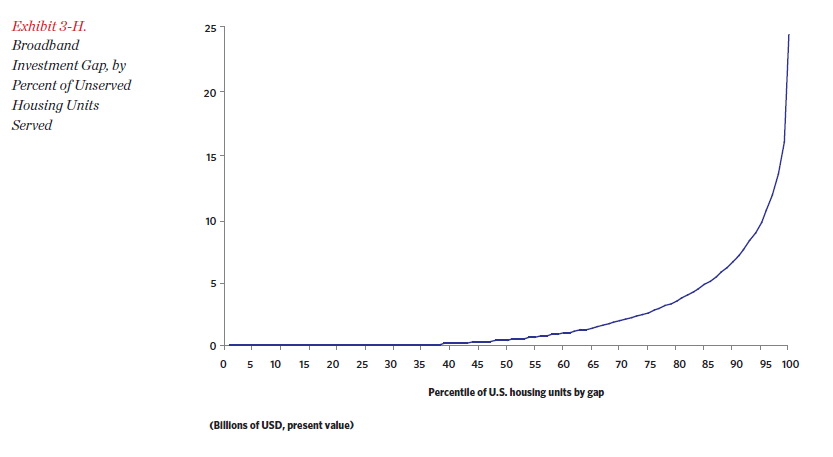The National Broadband Plan (NBP) estimates that firms would need subsidies totaling $23.5 billion to invest in the infrastructure necessary for universal broadband coverage in the United States (Exhibit 1-A, click to enlarge).[1]
The problem with the Plan’s estimate is that it includes only DSL and 4G wireless and omits broadband-over-satellite, which is by far the cheapest option for serving the most costly areas. Thus this “base case” grossly overstates the necessary costs of achieving 100% broadband availability.
The Broadband Plan notes that “while satellite is capable of delivering speeds that meet the National Broadband Availability Target, satellite capacity can meet only a small portion of broadband demand in unserved areas for the foreseeable future….[w]hile satellite can serve any given household, satellite capacity does not appear sufficient to serve every unserved household.” (p 137)
But satellite need not serve all “unserved” households. Serving only the highest-cost households would yield enormous savings.
The 250,000 housing units (0.2% of the U.S. total) with the highest costs account for $13.4 billion of the claimed investment gap (OBI Technical Paper No. 1, p 41). This eye-popping estimate reflects hypothetical decisions such as one to build out DSL to a single house in Orange County, NY for $366,126, which exceeds the county’s median home value, and to 30 dwellings in Kauai County, Hawaii at an average cost of $205,890 each, or about half of that county’s median.[2] Exhibit 3-H graphs the steep “hockey stick” costs implied by the base-case model.
In its technical supplement explaining the investment gap, the Broadband Team estimates that using satellite (with minor federal support) to serve those 250,000 homes would reduce the gap by at least $11.4 billion, or almost 50%.[3]
The authors have clearly considered the tremendous efficiencies afforded by satellite access, and acknowledge the adequacy of broadband-over-satellite at meeting the NBP requirement for connection quality.[4] Recommendation 8.13 urges the FCC to consider “alternative approaches, such as satellite broadband, for addressing the most costly areas of the country” (p 150). As such, the “broadband availability gap” as calculated should not be considered a strict endorsement of the technologies assumed (DSL and 4G), but rather a starting point for comparing the costs and benefits of alternative proposals.
To be sure, broadband-over-satellite has some drawbacks compared to other technologies. Existing satellite broadband plans offer slower download and upload speeds than most wireline or other wireless technologies, are more expensive, and exhibit higher latency due to extreme length of the “last mile” (more than 20,000 miles) to orbiting geostationary satellites. Speeds will become less of an issue with two new satellites expected to go into service in the next two years, both offering up to 10 Mbps downstream to homes; Hughes says it will even sell business plans of up to 25 Mbps.
The question then becomes whether it is worth spending an additional $12 billion to give those households a DSL or 4G wireless broadband option. To put that in perspective, consider that the U.S. government (NIH) budgets $50 million for discovery and development of drugs for “rare diseases”—defined as those affecting 200,000 or fewer people.[5] Many of those illnesses are deadly. Does it make sense to spend billions to allow 250,000 households the option of reducing delays in their Internet transmissions by half a second?
Apparently the Omnibus Broadband team didn’t think so. And thanks to the recent stimulus package, the USDA (the federal government’s longstanding supporter of rural broadband) is increasingly on board. It’s time we unite to make satellite broadband a priority in proposals for access in America’s most remote communities.
[1] The chart is actually taken from the corresponding technical supplement. In the Broadband Plan itself (See Section 8.1) the gap is referred to as the “broadband availability gap” and was pegged at $24.3 billion before the estimate was revised.
[2] Estimated costs of buildout reflect net cost (initial capex and ongoing support less revenue) with a 20-year time horizon and 11.25% discount rate (the NBP standard). Data on gap by county available at http://www.broadband.gov/maps/availability.htm
[3] The team reports the gap to be $10.1 billion—that is, reduced by a full $13.4 billion—when factoring in satellite “even with a potential buy-down” (p 41). It appears they have not factored in their estimate of a $800 million-$2 billion buy down, a program in which the government would subsidize subscriptions to existing (planned) satellite capacity to bring the expected high subscription charges to a level approaching terrestrial service (p 93-94). If necessitated, this cost would rightfully be subtracted from the savings, yielding the possible low of $11.4B reported above.
[4] That is, they acknowledge that satellite broadband will be sufficient for the “actual” 4 Mbps download, 1 Mbps upload minimum (NBP p 137).
[5] NIH requested this amount for the Therapeutic Rare and Neglected Diseases Initiative (see FY 2011 budget, p 5). The amount overstates the magnitude of spending per patient because the program also covers neglected diseases, from which very few Americans suffer, and because it includes more than 6,800 diseases classified as rare, which together afflict an estimated 25-30 million Americans.




